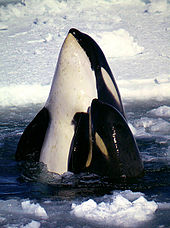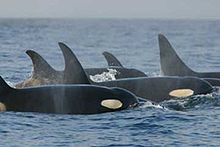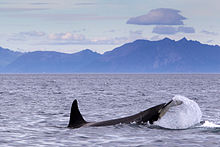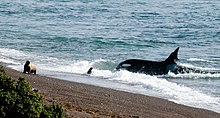
The orca, or killer whale, is a toothed whale that is the largest member of the oceanic dolphin family. It is the only extant species in the genus Orcinus. Orcas are recognizable by their black-and-white patterned body. A cosmopolitan species, they are found in diverse marine environments, from Arctic to Antarctic regions to tropical seas.

Cetacean intelligence is the overall intelligence and derived cognitive ability of aquatic mammals belonging in the infraorder Cetacea (cetaceans), including baleen whales, porpoises, and dolphins. In 2014, a study found for first time that the long-finned pilot whale has more neocortical neurons than any mammal studied to date, including humans.

Orcinus is a genus of Delphinidae, the family of carnivorous marine mammals known as dolphins. It includes the largest delphinid species, Orcinus orca, known as the orca or killer whale. Two extinct species are recognised, Orcinus paleorca and O. citoniensis, describing fossilised remains of the genus. The other extinct species O. meyeri is disputed.

Dall's porpoise is a species of porpoise endemic to the North Pacific. It is the largest of porpoises and the only member of the genus Phocoenoides. The species is named after American naturalist W. H. Dall.

The false killer whale is a species of oceanic dolphin that is the only extant representative of the genus Pseudorca. It is found in oceans worldwide but mainly in tropical regions. It was first described in 1846 as a species of porpoise based on a skull, which was revised when the first carcasses were observed in 1861. The name "false killer whale" comes from having a skull similar to the orca, or killer whale.
A5 Pod is a name given to a group of orcas found off the coast of British Columbia, Canada. It is part of the northern resident population of orcas - a name given to the fish-eating orcas found in coastal waters ranging from mid-Vancouver Island in British Columbia up through Haida Gwaii and into the southeastern portions of Alaska. The orcas of the Northern Resident community are divided into vocally distinctive clans known as the A clan, the G clan, and the R clan. Members of the A5 Pod belong to the A clan. As of 2013, A5 Pod consisted of 10 members.

The National Marine Fisheries Service (NMFS), informally known as NOAA Fisheries, is a United States federal agency within the U.S. Department of Commerce's National Oceanic and Atmospheric Administration (NOAA) that is responsible for the stewardship of U.S. national marine resources. It conserves and manages fisheries to promote sustainability and prevent lost economic potential associated with overfishing, declining species, and degraded habitats.
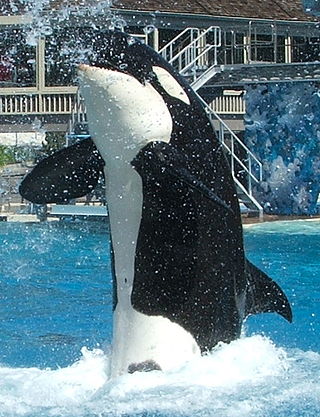
Dozens of orcas are held in captivity for breeding or performance purposes. The practice of capturing and displaying orcas in exhibitions began in the 1960s, and they soon became popular attractions at public aquariums and aquatic theme parks due to their intelligence, trainability, striking appearance, playfulness, and sheer size. As of 1 January 2024, around 59 orcas are in captivity worldwide, 35 of which were captive-born. At that time, there were 18 orcas in the SeaWorld parks.

Michael Andrew Bigg was an English-born Canadian marine biologist who is recognized as the founder of modern research on killer whales. With his colleagues, he developed new techniques for studying killer whales and, off British Columbia and Washington, conducted the first population census of the animals anywhere in the world. Bigg's work in wildlife photo-identification enabled the longitudinal study of individual killer whales, their travel patterns, and their social relationships in the wild, and revolutionized the study of cetaceans.

Ingrid Natasha Visser is a New Zealand marine biologist who studies orcas. She regularly lectures on the subject aboard cruise ships, especially in Antarctica, and has been featured in several documentaries about orcas.
Captured in 1964, Moby Doll was the first orca to survive in captivity for more than two days, and the second to be displayed in a public aquarium exhibit. The availability, for the first time, of an orca that could be studied at close quarters alive initiated pioneering research. From a recording of Moby Doll's calls, he was years later identified as a member of J Pod of the southern resident orcas.

The southern resident orcas, also known as the southern resident killer whales (SRKW), are the smallest of four communities of the exclusively fish-eating ecotype of orca in the northeast Pacific Ocean. The southern resident orcas form a closed society with no emigration or dispersal of individuals, and no gene flow with other orca populations. The fish-eating ecotype was historically given the name 'resident,' but other ecotypes named 'transient' and 'offshore' are also resident in the same area.

Granny, also known as J2, was a female orca of the J pod of southern resident orcas notable for her long life. Early estimates placed her birth in 1911, putting her at 105 years old at the time of her death. However, this estimate was later theorized to have been based on mistaken information and more recent studies put her at 65–80 years old. If she was 105, she would have been the oldest known orca at the time of her death. Granny lived in the northeast Pacific Ocean and coastal bays of Washington state and British Columbia. She was last seen on October 12, 2016, and was considered deceased by The Center for Whale Research in January 2017.
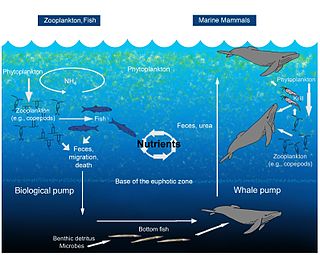
Whale feces, the excrement of whales, has a vital role in the ecology of oceans, earning whales the title of "marine ecosystem engineers." This significant ecological role stems from the nutrients and compounds found in whale feces, which have far-reaching effects on marine life.
Lance Barrett-Lennard is a Canadian biologist specializing in the behavioural ecology and population biology of killer whales. A molecular geneticist, Barrett-Lennard uses DNA analysis to study the dispersal, mating habits, and group structure of killer whale sub-populations in the Pacific Northwest. He is best known for his research concerning the conservation of the Southern Resident killer whale sub-population. As of 2022, he is a Senior Scientist in the Cetacean Conservation Research Program at the Raincoast Conservation Foundation.
Northern resident orcas, also known as northern resident killer whales (NRKW), are one of four separate, non-interbreeding communities of the exclusively fish-eating ecotype of orca in the northeast portion of the North Pacific Ocean. They live primarily off the coast of British Columbia (BC), Canada, and also travel to southeastern Alaska and northern Washington state in the United States. The northern resident population consists of three clans that consists of several pods with one or more matrilines within each pod. The northern residents are genetically distinct from the southern resident orcas and their calls are also quite distinct.
Eva Lucia Saulitis was an American marine biologist and poet, based in Alaska.
Moby Doll, who in 1964 in British Columbia became the second ever captive orca, was the first orca to be studied scientifically at close quarters alive.

The waters of the Salish Sea, on the west coast of North America, are home to several ecologically different populations of orcas. Primarily found in these nearshore waters are three major ecotypes: northern residents, southern residents, and transients. A fourth population, the offshore orcas, occasionally venture into nearshore waters as well. The different ecotypes are so named due to the fact that little direct interaction occurs between them; neither resident nor transient orcas have been observed to interbreed with one another, though occasional brief interactions do occur.
